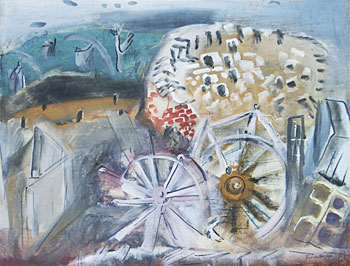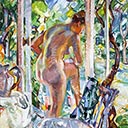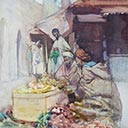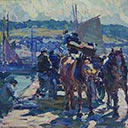Wheelwright, Solva
41 x 53.5 cm
Provenance: Ex collection Lionel Fraser Esq. J D Judelson Eq Private Collection, Christchurch
Reference: p. 103, Four Vital Years, Arthur R Howell, forward by John Piper, Rockcliff, Publishing, London
This gouache of Frances Hodgkins, completed when she was in her 70s, provides a clear example of her later work which moves into near abstraction and so different from the representational early work on offer, The Onion Seller, Tangier (Lot 38)
During the late 1930s and early 1940s Hodgkins' imagery was often taken from the farmyard and common items of the English countryside. The iconography of these works reveals the difficult times of World War Two and all its horrors, as well as her own sense of mortality.
The wheels of life or the wheels of fortune, or misfortune, dominate. The spokes of the right-hand wheel move beyond their enclosure to form the railings of a broken fence to the side of which is a surrealist rendition of gallows. The mauve and blue wheel has several spokes broken as well and some extend beyond the circle leading our eye to the green-blue field near the top where dark blue, somewhat calligraphic, lines suggest figures. On the far left is a conquering hero. But is it God or is it a man? To the right and slightly higher is a figure, equally enigmatic, in a gesture of embrace. Or is it about to slay someone? Behind both figures is a form painted in palest blue, the opposite of a shadow.
The third form from the left in this part of the painting suggests an ark with a rainbow shape stretching over it parallel to a similar form to the left. If it is a rainbow over the "sea" of green-blue, where are the rainbow's colours? To misquote Sir Christopher Wren: If you want to see colour just look around. In true early 20th century tradition, line and form became separate and discrete entities, and Hodgkins places the three primary colours, red, yellow, and blue strategically.
In the middle of the work is red, blobs of red, on either side of which are fields of yellow perhaps sullied with blood.
Variations of blue make up the upper portion of the work. Red is the colour of love, of sacrifice, of violence, a colour symbolising apparent opposites.
The secondary colours of pink and mauve form the left-hand wheel, while the hub of the right-hand wheel repeats the dirty yellow found elsewhere. Yet these are not the only wheels in the work. At the top right moving from the red blobs is a circle of white across which are anthropomorphic forms in various positions which, moving anti-clockwise, indicate fallen men, men about to fall with their hands tied behind their back, and men standing awaiting their fate. To the right we see more fallen figures.
In the middle of this circle are what might have been Dantesque shades but which now have arisen from the inferno and inhabit the "cemetery", their white tomb-like forms morphing into, again, anthropomorphic shapes.
The town of Solva is in North Pembrokeshire and lies at the mouth of the eponymous river. The Solva Woollen Mill, erected in 1907, was, and still is, powered by a 10 foot water-wheel which must have given an added impetus to the artist to repeat her much used form of the wheel which is to be found in so many of her late works and which is indicative of the wheels of carts and wagons to be found on the farms which surrounded her in the latter part of her life.
Her painting raises the question: Who is the maker of the wheel to which the title refers? Is it God or is it Man?
Hodgkins's treatment of the subject is lyrical and surreal, evocative of the end of the war and, indeed, the end of her own life. ANGELA MACKIE
References:
Gordon H. Brown The Reputation of Frances Hodgkins, in Art News, Issue no.16, Winter, 1980
Iain Buchanan, Michael Dunn and Elizabeth Eastmond: Frances Hodgkins Painting and Drawings, Auckland University Press, 2001
Joanne Drayton: Frances Hodgkins: A Private Viewing, Random House, Auckland, 2005
Dunn, Michael: New Zealand Painting: A Concise History, 2003, Auckland University Press





